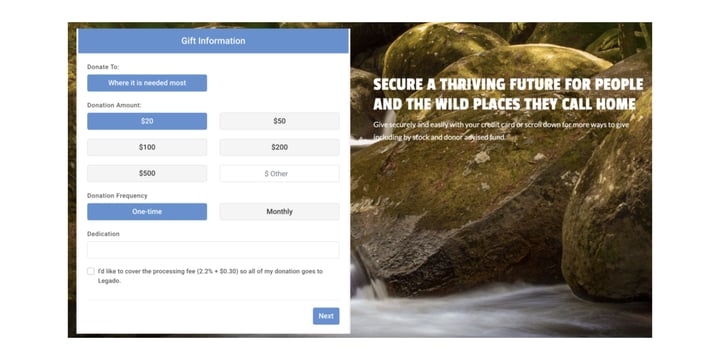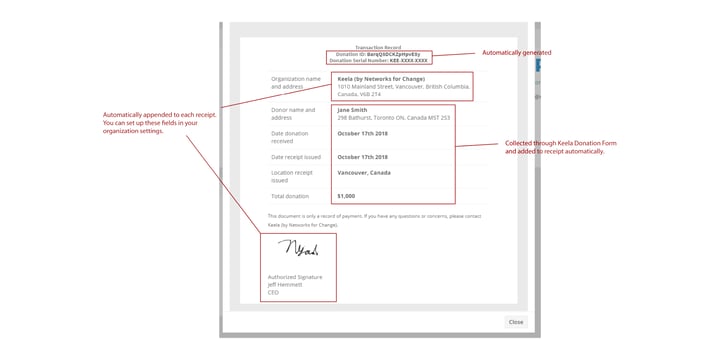Note: This blog post is republished with permission from Keela.
To carry out your nonprofit’s mission effectively, you need an easy way to collect online donations. Online fundraising saves your nonprofit precious time and resources that you would otherwise spend managing physical donation forms.
So, what’s the best way to collect donations online and encourage your donors to go digital? We developed a simple eight-step guide on how to accept and manage online donations. Whether you’re already processing donations online or just getting started, this guide unpacks the best way to collect online donations and maximize your digital contributions.

Here are eight steps to collect your donations online:
- Create a donation form
- Embed your donation form on your website
- Choose a payment processor
- Automate the distribution of donation receipts
- Segment your donor list
- Use emails to promote your donation form
- Identify your nondigital donors
- Ask your donors to go paperless
Let’s drill deeper into these steps together.
1. Create a Donation Form
The first step in collecting online donations is to create a donation form where you can direct potential donors to.
Remember, the goal of having a donation form, in the first place, is to make it easier for donors to give. Your donation form needs to be simple and easy to access. When potential donors visit your website to donate, they shouldn’t have to dig too far to find what they need. They should be able to find your donation form and support you within a few clicks.
Keela’s donation forms are customizable, mobile-responsive, and easy to use. With our donation forms, you can showcase your branding, communicate your story, and improve your donors' user experience. Most importantly, you can connect the form to the Keela CRM and track your donations and contact from one central software. See how Legado uses Keela’s form builder to create an appealing and simple donation form.

Notice how Legado’s donation form is beautifully designed. With the form, this nonprofit organization reminds visitors of its core mission. They included a link to their Annual Reports to show the impact of donors’ contributions. The form also clarifies that a donor receipt will be emailed to donors after they donate, which goes a long way to building credibility and trust.
Download a checklist with 17 tips for creating the perfect donation page.
2. Embed Your Donation Form on Your Website
By adding a donation form to your nonprofit’s website, you meet your donors where most of them are — online.
You have two options to collect donations through an online form: you can create a separate web page or embed the form directly on your website. We recommend embedding your donation form directly onto your website. This will help keep visitors and donors on your website longer and make them feel more comfortable as they make their donation.
3. Choose a Reliable Payment Processor
To accept donations online, you need to integrate a payment processor into your form or website. The most popular platforms for accepting online donations are PayPal and Stripe.
Both PayPal and Stripe offer nonprofit discounts, and as such, compared to other payment processors, they make it easier for you to recoup a more significant percentage of your donations. With Keela donation forms, your donors can donate conveniently using PayPal or Stripe.
4. Automate the Distribution of Donation Receipts
The next step has to do with donation receipts. Your donation receipts should be automatically sent to your donors in a PDF document to save time and reduce stress. If you’re using Keela, it’s pretty easy to do this since the whole process is automated.
As soon as a gift is received through a Keela online donation form, the receipt is automatically generated and emailed to donors immediately. The donation receipt includes the Donation ID, Serial Number, Organization Name and Address, and Signatures. For recurring donations, the donors can choose to receive a receipt for every gift or a cumulative receipt at the end of the year.

In a free on-demand webinar, you can learn the secrets and best practices that leading nonprofits use to execute successful online fundraising campaigns.
5. Segment Your Donor Email List
Email is the best way to stay in touch with your donors and send updates about your organization. Creating effective email campaigns will result in more donations down the line. With solid email communications, you can engage your donors, communicate your impact, and remind them how important their gifts are to your mission.
However, for your email communications to be effective, you need to understand your donors. Segmenting your donors based on their giving history will help you identify your most and least engaged supporters. With this information, you can send targeted messages to each donor segment to encourage them to take action.
For instance, you can start by splitting your database between one-time donors and recurring donors. You’ll use a slightly different message for each group in your communications because their relationship to your organization is somewhat different — the more personal your message, the better. Donors are more likely to give when they receive the targeted, personalized communication from you.
6. Use Emails to Promote Your Donation Form
Now that you have successfully identified your donor segments, you can communicate with them in the right way. Keela CRM includes E-blast (or email marketing) tools so you can reach out to your contacts using beautifully designed emails.
The E-blast builder allows for personalization. As long as you have the contact information saved in your database, you can refer to the donors by their first name and last name or include any other relevant contact data. Whatever you do, be sure to include a donate button in your email. Remember, your donors should be able to access your donation form easily.
7. Identify Your Nondigital Donors
In your database, you probably have a list of donors who didn’t share their email addresses with you — and that’s okay. These donors may usually mail in their donations. But ideally, and if they can, they ought to make their donations online, so consider asking them to use your online donation forms.
Let them know how much of a timesaver this will be for your organization in the future. If you’re using Keela’s donation forms and CRM, you can reassure them that your forms are safe and secure and your CRM complies with mass emailing rules and anti-spam laws
So, what’s the best way to ask for online donations? First, you need to identify those donors whose emails are missing from your database. Then, make a Smart List for those contacts who don’t currently have a primary email address on file and export this list for a mail merge.
8. Ask Your Donors to Go Paperless
Now that you’ve created a list of donors who don’t give online, you can send a letter asking them to go paperless.
The letter should explain why removing paper receipts helps your nonprofit organization save time and money on printing, mailing, and other manual processes. Highlight how this transition also helps to reduce paper waste and support a healthier environment.
Then, you can offer those donors two choices: they can either donate online next time on your website or send your organization an email to provide their email address. Finally, you can update your database with this information.
To help you save time with this process, we put together eight donation letter templates that you can use to ask your donors to go digital.
Accepting donations online is one step toward improving your digital fundraising strategy.
At Keela, our mission is to help you raise more money and save more time. Setting up an effective transition toward online donations will spare you time-consuming manual processes and ultimately improve your fundraising outcomes.
We hope that this guide helps you raise more money and do more good!
Top photo: Shutterstock








